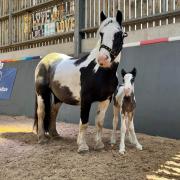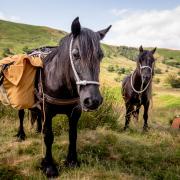A touring exhibition of striking images records the lives of the farmers who keep our uplands alive. Mike Glover reports

When the controversial environmental writer George Monbiot blamed sheep for the floods that devastated the south west of England, one furious farmer said: ‘I’d like Mr Monbiot to see what the life of an uplands farmer means.’

Well, one artistic couple can save him the trouble. For that is exactly what they have done. For two years husband and wife, Rob and Harriet Fraser, have immersed themselves in life on the Lake District fells recording a culture that goes back 1,000 years and has shaped the country’s biggest national park.
They have recorded in words and pictures every aspect and stage of the farmer’s lifestyle. They also talked to many other key stake-holders in the environment.
Their results have been compiled into an exhibition, Land Keepers, on display at Wordsworth Museum, Grasmere, (until May 11) and which will then be transported to Sizergh Barn, near Kendal (from July to September) and on to the Royal Geographical Society in Kensington.
Rob and Harriet, from New Hutton, near Kendal, did not set out to create a polemic on behalf of the farmers, but rather a permanent record of their part in the complex and challenging landscape which attracts 17 million visitors a year.
The result is a moving and powerful tribute to human endeavour as well as a carefully constructed plea for balance in the management of such a delicate environment.
‘We wanted to create a documentary that described and informed, from the farmers’ point of view, how their lives interact with the landscape,’ said Harriet.
Rob, a 51-year-old photographer and mountain guide, and writer Harriet, aged 44, studied ten valleys in what is the biggest tract of uplands in Western Europe, much of it common land to which the Herdwick sheep are hefted. This is the way the sheep through the generations know their own patch.
‘We found that it applied to the farmers who know their own land as well, having grown up on it and once adults, in turn teach their children. The exhibition reflects the part that farmers play in the wider picture and the fact that their voices often don’t get heard. We wanted to give them that chance,’ she said.
The germ of the idea started six years ago when Rob was photographing barns. When he stopped to ask farmers’ permission, he found they had a great desire to communicate their stories. He and Harriet held a pilot project in 2011.
They found a huge willingness and enthusiasm to embark on the two year project, not just from the farmers, but also from sponsors like DEFRA’s rural development fund, the farmers’ network, Booths the grocery group, and rural art charity Littoral Arts.
‘Nationally, people are talking about the value of farmers, whether they are good or bad for the landscape, and hopefully this provides a platform for the different viewpoints to be heard.
‘We found that the culture of farmers living in the landscape is extremely vital to the fells, holding up the communities. After all they farm 50% of the uplands,’ said Harriet.
They started at Keswick Tup Fair and made contacts which enabled them to gain the trust of farmers across the Lake District.
They took part in gathering of livestock on the fells, attended shows, auction sales and sheep shearing competitions. They visited an abattoir, scanning sessions and inspections and helped with dry-stone walling. They even joined in clouting, which involves fitting cloth chastity belts to young ewes to prevent tups impregnating them.
Rob is keen to emphasise that there is no one-size-fits-all solution to managing the fells. Each valley needs careful investigation to see how much grazing it can accommodate.
He adopted an interesting mixture of methods for taking his photographs: portraits in black and white, with a cloth-over-the-head, large plate camera, with the film developed in chemicals in the dark room.
Candid action shots were done with a modern Nikon digital camera. The results are striking.
The connection with Wordsworth Trust which hosts the exhibition until May 11 is a poignant one, as much of the great romantic poet’s work was inspired by and featured the rural idyll he found in the Lake District.
His poem ‘Michael’ conveys the sadness when a farmer’s son leaves the land and goes off the rails, never to return. Harriet and Rob find their own Michael, surname Longworth, a 23-year-old who had spent eight years learning the farming ropes before leaving the Lakes as he couldn’t find a farm of his own. In a better outcome than Wordsworth’s Michael, he has found his own place in Derbyshire. Harriet has written her own poetic record of the modern Michael.
‘We don’t want the exhibition to be seen as doom and gloom. There are challenges – on average only about 15% of their revenue comes from farming – but farmers are pragmatic and the message is that it needs a balanced view,’ said Harriet.
‘We are rather celebrating a really important part of Cumbria. Farmers are resilient and adaptable to change. They always have been, and always will be.’
A view from the farm
‘We’ve farmed in this area for the last 300 years. In many instances a sheep flock will have seen a family through the generations, centuries, through good and bad. You’ve got that much heritage, that much culture, that much empathy, that much of a link with your sheep flock – it is part of your blood almost.’ - Will Cockbain, Rakefoot Farm, Keswick.
‘We only put up walls to keep sheep in – we don’t put them up to look at. They’re there for a job aren’t they? They’re there to keep sheep in, an’ if you get rid of the sheep, you don’t need walls, do you?’ - Mike and Phil Edmondson, of Great Langdale.
For more information visit www.landkeepers.co.uk.
Prince’s Countryside Fund
Lancashire Life is supporting The Prince’s Countryside Fund by highlighting many of the positive things happening in the north west’s rural communities. The fund gives grants to projects that help support the people who care for the countryside and is supported by a unique collaboration of businesses working together to secure a sustainable future for British agriculture and the wider rural economy.
Grants of up to £50,000 are made to projects that are improving service provision in rural areas, support rural enterprise, support farming businesses, and provide training opportunities for young people and educating people about the value of the countryside.
So far the fund has donated in excess of £3.87 million in grants to almost 90 projects, many in our region. It also provided £50,000 of emergency aid to flood-hit Somerset.



























